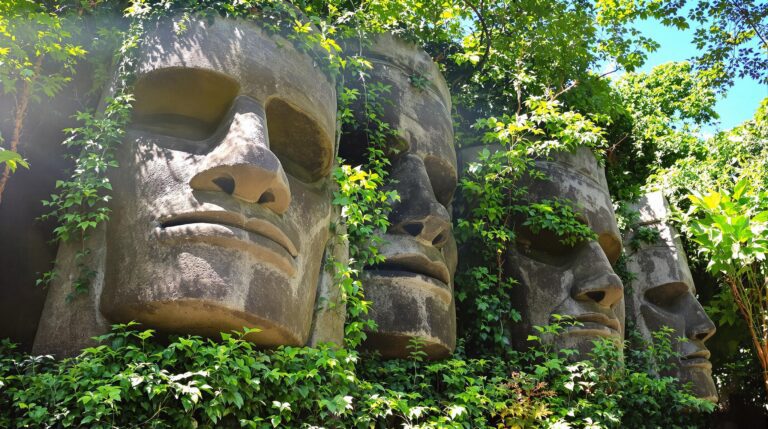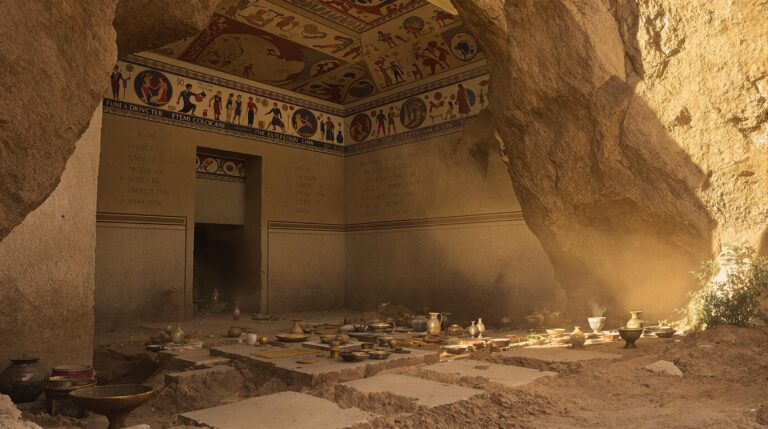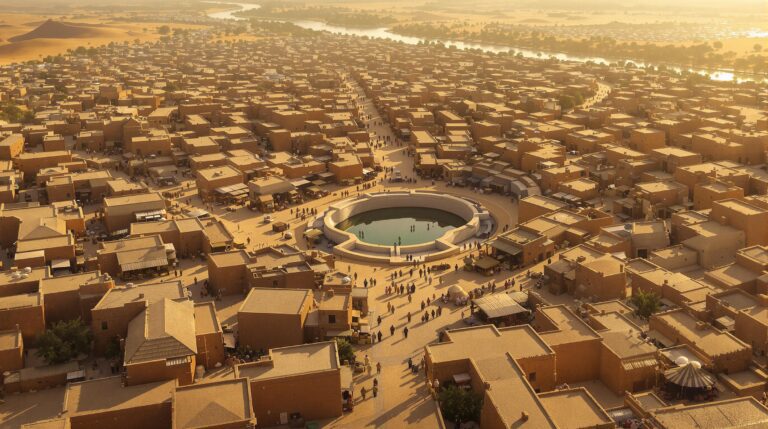Ancient Japan: Jomon Culture Secrets
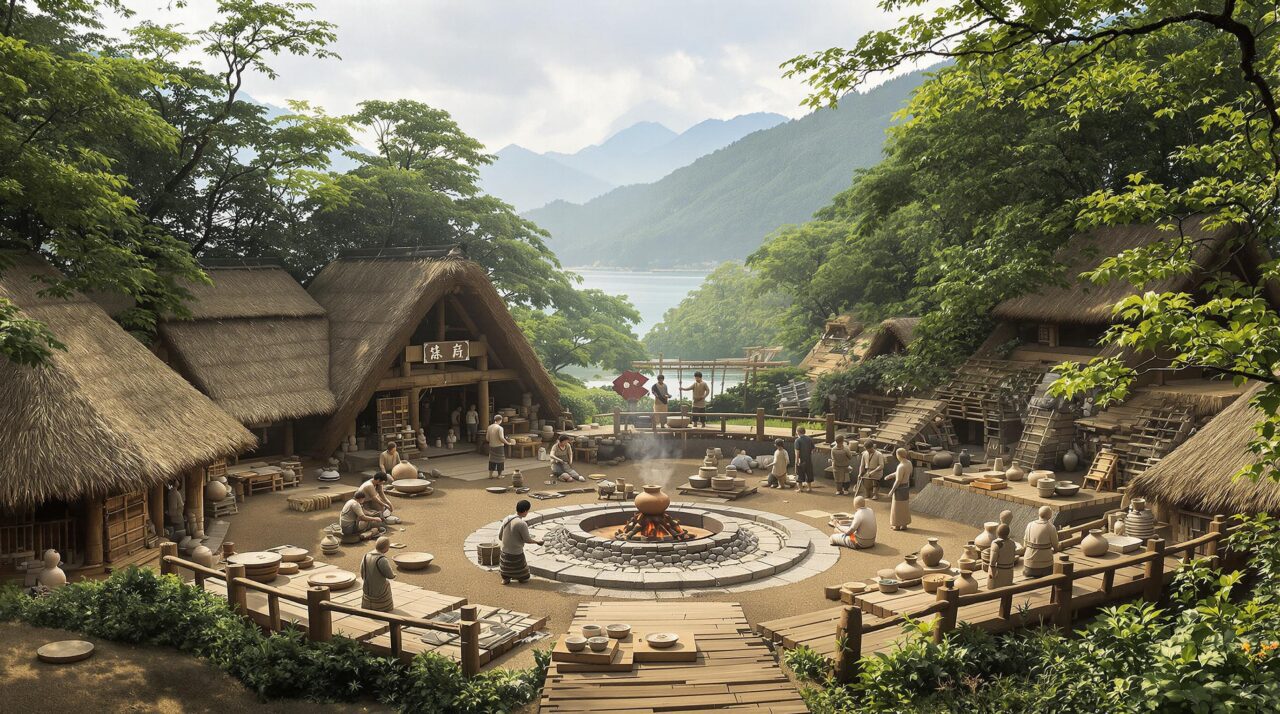
The Jomon culture of ancient Japan stands as a demonstration of human ingenuity and adaptability.
Spanning over 14,000 years, this society crafted intricate pottery and established deep-rooted connections with their environment.
Their daily lives intertwined spirituality with communal living, fostering a unique social fabric.
Yet, the mysteries of their legacy linger in modern Japan. What insights can their practices offer today, and how do they shape contemporary identity? The exploration unfolds further.
Principal Conclusions
Hide- Jomon culture, meaning "cord-marked," is known for its distinctive pottery dating back to 14,000 BCE, showcasing early artistic expression.
- Semi-permanent pit houses reveal a harmonious relationship with nature and community, reflecting the Jomon people's innovative architectural techniques.
- Clan-based social structures fostered unity, with roles for elders and shamans guiding spiritual beliefs and community practices.
- Trade networks enriched Jomon life through exchanges of jade and obsidian, enhancing material culture and social connections among distant communities.
- Spirituality is evident in Dogu figurines and burial practices, highlighting the Jomon people's deep connections to nature and the afterlife.
The Origins of the Jomon Period in Ancient Japan
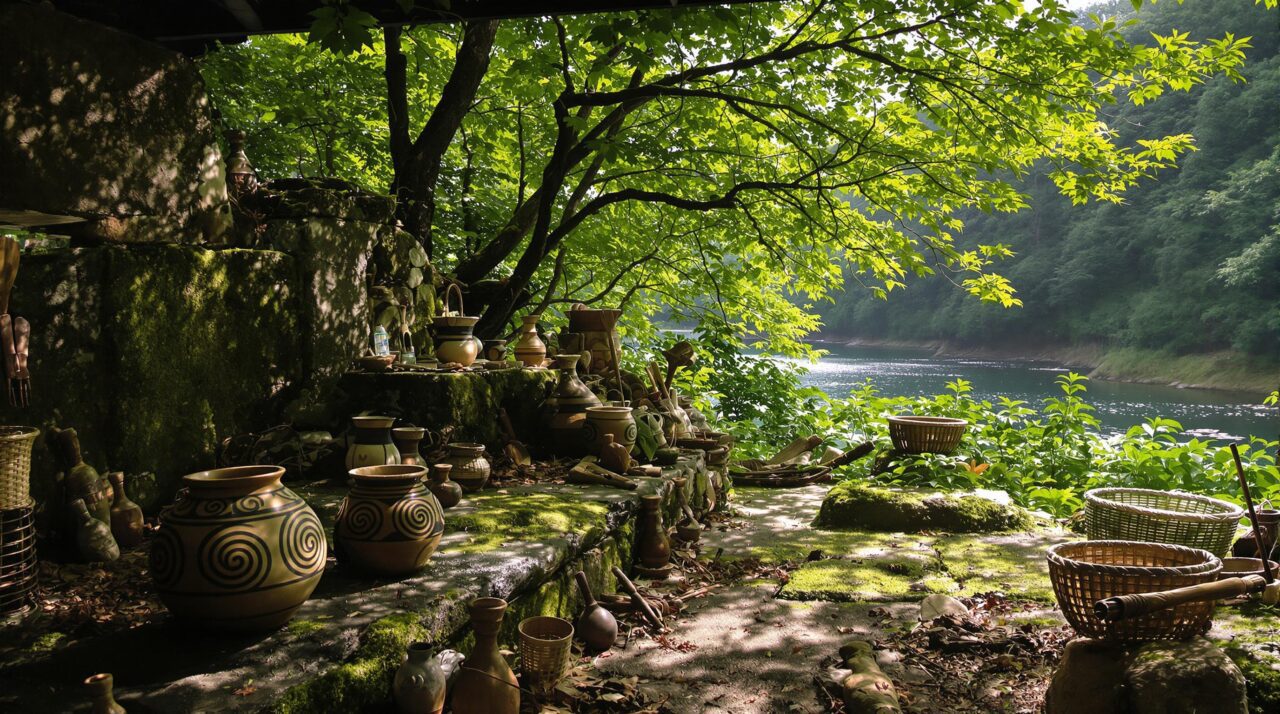
The term “Jomon,” meaning “cord-marked,” evokes a vibrant mosaic of prehistoric life, intricately woven into the very fabric of Japan’s early existence.
Spanning from approximately 14,000 BCE to 300 BCE, this era witnessed the emergence of settlements characterized by innovative lifestyles that harmonized with the natural world.
As archaeologists sift through remnants of pottery and dwellings, they uncover a narrative that reveals the profound connection between early humans and their environment, setting the stage for a culture that would endure for millennia.
The Meaning Behind “Jomon” and Its Timeline
The term “Jomon,” meaning “cord-marked,” evokes the intricate artistry of ancient Japanese pottery, characterized by its distinctive patterns created through the use of twisted cords.
Spanning from approximately 14,000 to 300 BCE, this period showcases a remarkable timeline of cultural evolution and regional diversity across the Japanese archipelago.
As these artifacts emerged, they not only reflected the ingenuity of their makers but also hinted at the complex societal structures that flourished in prehistoric Japan.
Definition of “cord-marked” pottery
Cord-marked pottery stands as a defining characteristic of the Jomon culture, an ancient civilization that flourished in Japan from approximately 14,000 to 300 BCE.
This distinctive pottery features intricate patterns created by pressing cords into the clay, reflecting the artisans’ connection to nature and ritual.
- Lost Glory of the Nubian Kingdom of Kush
- Harappan Civilization: Inside the Planned Cities of the Indus Valley
- Etruscan Civilization: Secrets of the Etruscans Uncovered
- Ancient Persia: Golden Age and the Achaemenid Legacy
- Göbekli Tepe Mystery: Ancient Site Redefines History
- Sumerian Secrets: The Birthplace of Ancient Innovations
Each vessel tells a story, encapsulating the spirit of a society that thrived on creativity and communal expression.
Timeframe and regional spread across Japan
Emerging from the mists of prehistory, the Jomon period, which spans from approximately 14,000 to 300 BCE, encapsulates a remarkable era in Japan’s past.
This era flourished across diverse landscapes, from the northernmost Hokkaido to the southern reaches of Kyushu. Each region, marked by unique adaptations and innovations, revealed a tapestry of life that resonated with harmony, resourcefulness, and profound connection to nature.
Early Settlements and Lifestyle Patterns
In the heart of the Jomon Period, early settlers crafted semi-permanent dwellings, known as pit houses, that melded seamlessly with the rhythms of nature.
Their hunter-gatherer strategies, marked by seasonal mobility, reveal a profound understanding of the landscapes that nourished them.
These patterns of habitation and movement not only shaped their daily lives but also laid the foundation for a culture intricately connected to the ebb and flow of the environment.
Semi-permanent dwellings and pit houses
The Jomon Period, spanning thousands of years, reveals a fascinating tapestry of early human adaptation, particularly through its semi-permanent dwellings and pit houses.
These architectural innovations reflect a harmonious relationship with nature and community needs:
- Earthy materials that blend with surroundings
- Efficient designs for warmth and safety
- Spaces fostering social interaction and culture
Such dwellings symbolize the resilience and ingenuity of Jomon society, crafting a legacy of freedom.
Hunter-gatherer strategies with seasonal mobility
Jomon people’s hunter-gatherer strategies were a demonstration of their deep understanding of the natural world, intricately woven into the fabric of their seasonal mobility.
They deftly navigated diverse landscapes, aligning their movements with the rhythms of nature. This adaptability allowed them to exploit resources, fostering sustainability while embracing the freedom of exploration—a reflection of their profound connection with the environment and the cycles of life.
Daily Life and Material Culture
In the heart of the Jomon period, daily life unfolded in a tapestry woven with intricate pottery and finely crafted tools that transcended mere utility.
Each vessel, adorned with unique designs, not only served as a functional item but also as a tribute to the artistic spirit and cultural identity of its creators.
The craftsmanship reflected a deep connection to the natural world, revealing how the Jomon people harmonized their existence with the environment around them.
Pottery That Redefined Prehistoric Art
The pottery of the Jomon culture stands as a demonstration to the intricate interplay between artistry and utility, showcasing decorative styles that transcended mere functionality.
Variations across regions reveal not only aesthetic preferences but also a diverse fabric of symbolic patterns that speak to the values and beliefs of these prehistoric communities.
Through these vessels, the essence of daily life and material culture emerges, offering profound insights into the human experience of the time.
Decorative styles and functional uses
Crafted with both artistry and purpose, the pottery of the Jomon culture reveals a profound connection between aesthetic expression and daily functionality.
Each piece serves a dual role, echoing the culture’s harmonious balance between form and utility.
Key aspects include:
- Intricate designs that reflect spiritual beliefs
- Versatile shapes for cooking, storage, and ritual
- Textured surfaces enhancing grip and visual appeal
These elements embody a unique cultural legacy.
Regional variations and symbolic patterns
While exploring the diverse landscapes of ancient Japan, one can uncover a tapestry of regional variations in Jomon pottery that not only reflect local resources but also convey deep symbolic meanings.
Each vessel, adorned with unique patterns, tells stories of ancestral beliefs and communal identity, revealing a culture rich in spirituality and artistry, where every curve and mark resonates with the echoes of the past.
Tools, Ornaments, and Craftsmanship
In the heart of Jomon culture lies a remarkable array of tools and ornaments that reveal the ingenuity of its people.
Stone implements and intricate fishing gear speak to a life deeply intertwined with nature, while delicate bone needles and enchanting jewelry crafted from clay and shell showcase their artistic flair.
These artifacts not only served practical purposes but also illuminate the vibrant mosaic of daily life and material culture in a society that thrived in harmony with its environment.
Stone tools, fishing gear, and bone needles
Jomon culture thrived through ingenuity, as its people skillfully fashioned stone tools, fishing gear, and bone needles that reflect a deep understanding of their environment.
These artifacts demonstrate remarkable craftsmanship and adaptability, essential for survival in a dynamic landscape.
- Precision tools for hunting and gathering
- Ingenious fishing implements for sustenance
- Bone needles for creating durable clothing
Jewelry and figurines made from clay and shell
As the Jomon people honed their skills in crafting tools and fishing gear, another dimension of their creativity emerged through the creation of jewelry and figurines made from clay and shell.
These artifacts, rich in symbolism and artistry, reflected not only personal adornment but also cultural beliefs, connecting the tangible to the spiritual, and revealing a profound appreciation for beauty amidst the rhythms of daily life.
Spiritual Beliefs and Ritual Objects
Amidst the serene landscapes of ancient Japan, the Jomon people crafted enigmatic Dogu figurines that whisper secrets of their spiritual beliefs and the mysteries of existence.
These intricate artifacts, alongside elaborate burial practices and sacred spaces, reveal a profound connection between the living and the spiritual domains, illuminating their quest for understanding life and death.
As the remnants of their rituals surface, they beckon us to ponder the deep-rooted significance behind these objects, inviting us into a world where the spiritual and material coalesce.
Mysterious Dogu Figurines and Their Purpose
The enigmatic Dogu figurines, with their stylized human forms and exaggerated features, beckon the curious to unravel their significance within Jomon culture.
Scholars propose theories that range from fertility symbols to spiritual guardians, each interpretation offering a glimpse into the profound beliefs of their creators.
As these artifacts stand silently, they provoke questions about the rituals and spiritual connections that once thrived in a world now lost to time.
Stylized human forms and exaggerated features
What mysteries lie behind the enigmatic Dogu figurines of the Jomon culture? Their stylized forms and exaggerated features invite speculation about their purpose and meaning.
- Distinctive facial expressions hint at emotional or spiritual significance.
- Unique body proportions challenge conventional aesthetics.
- Intricate designs suggest a connection to ritual practices.
These intriguing artifacts beckon deeper exploration into the minds of their creators.
Theories ranging from fertility to spiritual guardians
Intriguing theories abound regarding the purpose of the Dogu figurines, with interpretations ranging from symbols of fertility to spiritual guardians.
Scholars speculate that these enigmatic artifacts served as conduits for ancestral spirits or as talismans to guarantee bountiful harvests.
Their exaggerated features evoke a sense of mystery, inviting an exploration of the Jomon people’s deep-seated beliefs in the intertwining of life, death, and the spiritual domain.
Burial Practices and Sacred Spaces
In the heart of Jomon culture, burial practices reveal a profound connection between the living and the spiritual domain.
Community cemeteries, adorned with grave offerings, hint at a collective reverence for the deceased, while circular ritual sites and stone arrangements evoke an air of mystery surrounding their ceremonial significance.
These sacred spaces serve as poignant reminders of a society deeply engaged with the cycles of life, death, and the unseen forces that bind them.
Grave offerings and community cemeteries
Numerous grave offerings and meticulously arranged community cemeteries reveal the profound spiritual beliefs of the Jomon people, illuminating their connection to both the living and the dead.
These sacred spaces were marked by:
- Crafted pottery symbolizing abundance
- Tools reflecting daily life and craftsmanship
- Personal items, showcasing individual identities
Such offerings encapsulated a reverence for the afterlife and a desire for continuity beyond death.
Circular ritual sites and stone arrangements
Circular ritual sites and stone arrangements stand as proof of the Jomon people’s complex spiritual landscape, encapsulating their beliefs and practices surrounding life, death, and the cosmos.
These enigmatic formations reveal a deep reverence for nature, serving as sacred spaces for communal rituals. They invite contemplation of existence, allowing the Jomon to connect with the divine, shaping their identity through transcendent experiences and shared spiritual journeys.
Social Structures and Village Organization
In the intricate tapestry of Jomon culture, clan-based living emerged as a cornerstone of social organization, weaving together families into tight-knit communities.
Evidence suggests that these villages were not isolated, but rather lively hubs of trade and interaction, fostering relationships across regions and enriching cultural exchanges.
Such dynamics not only shaped their identity but also left an indelible mark on the landscape of ancient Japan.
Evidence of Clan-Based Living
In the heart of the Jomon landscape, circular settlements emerge as a proof of a communal way of life, where shared infrastructure fosters a sense of unity among clans.
Within these lively enclaves, the roles of elders, shamans, and artisans weave a complex tapestry of social hierarchy and spiritual guidance, illuminating the intricate dynamics at play.
This organization not only reflects the adaptability of the Jomon people but also their profound connection to one another and the world around them.
Circular settlements and shared infrastructure
Nestled within the lush landscapes of ancient Japan, circular settlements stand as a tribute to the Jomon culture‘s intricate social structures and communal values.
These settlements reveal fascinating insights into their way of life, characterized by:
- Cooperative agricultural practices
- Shared resources and communal spaces
- Clan-based organization that fostered unity
Such infrastructure exemplifies the Jomon people’s deep connection to both land and community.
Roles of elders, shamans, and artisans
The intricate tapestry of Jomon society was woven not only through their circular settlements but also through the pivotal roles played by elders, shamans, and artisans.
Elders served as wisdom keepers, guiding clans with their experience.
Shamans connected the spiritual and earthly domains, mediating essential rituals.
Artisans, with their creative prowess, crafted tools and ornaments, enriching communal identity and fostering a profound sense of belonging.
Trade and Interactions Among Regions
In the intricate web of Jomon society, trade emerged as a powerful catalyst, binding distant communities through the allure of jade and obsidian.
Coastal exchanges not only enriched their material culture but also sowed the seeds for future artistic and technological innovations.
The shared pottery styles that transcended regional boundaries whisper tales of collaboration and influence, marking the Jomon’s legacy in the annals of human history.
Jade, obsidian, and coastal trade items
Jade and obsidian, shimmering relics of the earth, served as essential currencies in the intricate web of trade that defined the Jomon culture.
These prized materials enabled lively exchanges among coastal communities, fostering connections.
Key items included:
- Intricate jade ornaments symbolizing status
- Sharp obsidian tools for survival
- Exotic coastal goods, enhancing local economies
Such trade facilitated social structures and enriched the Jomon experience.
Pottery exchanges and influence on later groups
While the allure of jade and obsidian captivated the Jomon people, it was the artistry of their pottery that truly shaped social dynamics and village organization within and beyond their communities.
Pottery exchanges fostered relationships between disparate groups, creating networks of trade and cultural influence.
This shared craftsmanship laid the groundwork for future societies, echoing through generations and enriching Japan’s historical tapestry.
The Jomon Connection to Nature
The Jomon people forged an intricate bond with their natural surroundings, mastering the art of fishing and foraging to sustain their communities.
Their ingenuity in food storage and early cultivation of domesticated plants reveals a profound understanding of the cycles of nature, actively shaping their environment while remaining attuned to its rhythms.
This connection not only provided sustenance but also fostered a spiritual relationship with the land, illustrating how deeply intertwined their existence was with the world around them.
Fishing, Foraging, and Food Storage
The Jomon people’s intricate relationship with their environment is vividly illustrated through the remnants of shell mounds, which whisper tales of abundant marine harvests and communal feasting.
Evidence of storage pits reveals a sophisticated understanding of food preservation, where fermented plants transformed into sustenance for harsh winters.
This connection to nature not only sustained them but also shaped their cultural identity, intertwining survival with reverence for the land.
Shell mounds and preserved food evidence
Amidst the rugged landscapes of ancient Japan, the enduring legacy of Jomon culture reveals itself through the intricate shell mounds that dot the coastline.
These mounds signify a deep connection to nature, showcasing their resourcefulness in food preservation.
- Evidence of marine life consumption
- Unique culinary practices
- Insights into seasonal foraging
Together, they paint a vivid picture of Jomon ingenuity and harmonious existence with the environment.
Storage pits and fermented plant use
Storage pits, a hallmark of Jomon ingenuity, reveal a sophisticated understanding of food preservation that transcended mere survival.
These subterranean chambers facilitated the fermentation of plants, transforming humble ingredients into flavorful staples.
This mastery of storage reflects a deep connection to nature, as the Jomon people embraced the rhythms of their environment, cultivating resilience through innovative practices that nourished both body and spirit.
Domesticated Plants and Early Cultivation
The Jomon culture reveals a fascinating interplay between humanity and the natural world, where chestnuts and beans emerged as essential staples in their diet.
Emerging signs of proto-agriculture hint at a transformative shift, sparking debate among scholars about the origins of food production in this ancient society.
As the Jomon people cultivated these plants, they not only shaped their sustenance but also forged a deeper connection to the land that would define their legacy.
Chestnuts, beans, and signs of proto-agriculture
In the verdant landscapes of ancient Japan, the Jomon people forged a unique relationship with their environment, transforming wild resources into the foundations of early agriculture.
Their exploration included:
- Chestnuts: A staple, symbolizing nourishment and community.
- Beans: Essential for protein, showcasing early plant domestication.
- Seeds: Indicators of burgeoning agricultural practices, revealing an intimate connection with nature.
These elements signified the Jomon’s innovative spirit and adaptability.
Debate over the beginnings of food production
Often overlooked in the broader discourse on early food production, the Jomon people’s connection to their environment reveals a complex interplay between wild foraging and the nascent stages of agriculture.
Archaeological evidence suggests they nurtured wild plants, hinting at an intentional shift towards cultivation. This debate invites a reevaluation of how early communities shaped their landscapes, intertwining survival with a profound respect for nature’s bounty.
Legacy of the Jomon in Japanese Identity
The legacy of the Jomon culture weaves an intricate mosaic within the fabric of Japanese identity, echoing through centuries of history and modern expression.
Recent archaeological discoveries illuminate the profound connections between ancient practices and contemporary cultural narratives, revealing a continuity that transcends time.
As the whispers of the past resonate in art, tradition, and belief, the essence of Jomon becomes an essential thread in the ongoing story of Japan.
Influence on Later Periods and Modern Culture
The legacy of the Jomon culture reverberates through the ages, manifesting in the traditions of the Yayoi and Ainu peoples, where ancient practices subtly intertwine with modern identity.
This enduring connection invites a renewed appreciation in contemporary society, as artists and cultural advocates breathe life into Jomon aesthetics, enriching the tapestry of Japanese heritage.
In exploring these threads, one uncovers a profound narrative of continuity that shapes the very essence of what it means to be Japanese today.
Continuity seen in Yayoi and Ainu traditions
While the Jomon culture laid the foundation for Japan’s prehistoric identity, its enduring influence can be seen in the traditions of both the Yayoi and Ainu peoples.
- Agricultural practices rooted in Jomon techniques
- Artistic expressions reflecting ancient motifs
- Spiritual beliefs that honor nature’s cycles
These elements illustrate a profound continuity, weaving the past into the fabric of modern Japanese identity, celebrating freedom and resilience through time.
Artistic reverence and cultural revival today
As contemporary Japanese society reclaims its roots, the artistic reverence for Jomon culture emerges as a lively thread woven into the modern tapestry of identity.
Contemporary artists draw inspiration from ancient pottery and weaving techniques, celebrating Jomon aesthetics. This revival embodies a quest for authenticity, connecting past and present, as the echoes of ancestral wisdom resonate deeply in the dynamic expressions of today’s cultural landscape.
Archaeological Discoveries and What They Reveal
The excavation of major sites like Sannai-Maruyama has disclosed a treasure trove of artifacts that challenge prevailing narratives of Japan’s ancient past.
These discoveries illuminate the intricate tapestry of Jomon culture, revealing a sophisticated society deeply woven into the fabric of Japanese identity.
As researchers piece together these ancient remnants, they reshape the understanding of the Jomon’s enduring legacy in contemporary Japan.
Major excavation sites like Sannai-Maruyama
Sannai-Maruyama stands as a monumental proof to the Jomon culture, revealing layers of human ingenuity and connection to nature that resonate through time.
This site captivates scholars and enthusiasts alike, offering insights into:
- Architectural sophistication in ancient dwellings
- Exquisite pottery showcasing artistic expression
- Evidence of communal living and resource sharing
Such discoveries illuminate the essence of Jomon identity, enriching Japan’s historical tapestry.
How research reshapes Japan’s ancient narrative
How does the legacy of the Jomon culture continue to influence contemporary Japanese identity?
Recent archaeological discoveries reveal a complex mosaic of innovation and creativity, challenging long-held narratives.
As researchers explore ancient artifacts, they illuminate connections between past and present, fostering a renewed appreciation for indigenous roots.
This exploration not only reshapes historical understanding but also ignites a sense of cultural freedom among modern Japanese society.
Wrapping Up
The Jomon culture, with its vibrant mosaic of resilience and creativity, laid the foundation for Japan’s enduring identity.
Remarkably, archaeological findings suggest that Jomon pottery dates back over 14,000 years, making it some of the oldest in the world.
This ancient society’s profound connection to nature and community continues to resonate, echoing through modern Japanese art and spirituality.
As the Jomon legacy unfolds, it invites a deeper appreciation for the intricate dance between humanity and the natural world.
